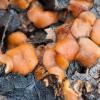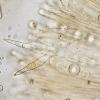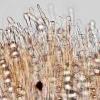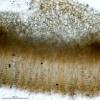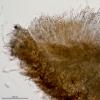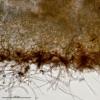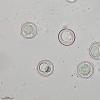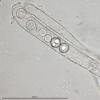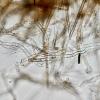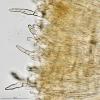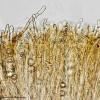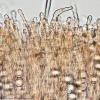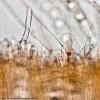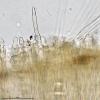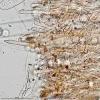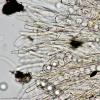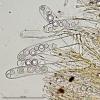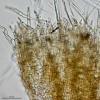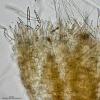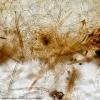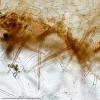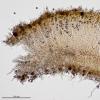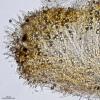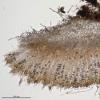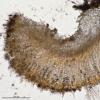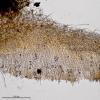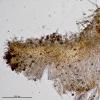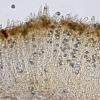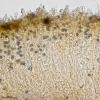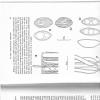
28-12-2025 12:08
Margot en Geert VullingsThis possible Karstenia was found on the bark of d

21-12-2025 21:32
Pol DebaenstHello, Garden, Burgweg 19, Veurne, BelgiumOn 10/1

26-12-2025 21:19
Arnold B眉schlenPithyella chalaudii Priou. Ist als Bryoparasit in

21-12-2025 09:32
Hello.A tiny ascomycete found embedded in wood in

18-12-2025 21:17
Pol DebaenstThe identification took me to Byssonectria deformi

24-12-2025 17:08
Hulda Caroline HolteHello, I have found this propoloid ascomycete on
 Has Sphaerosporella brunnea in the hymenium the same hairs than margin ones?
Has Sphaerosporella brunnea in the hymenium the same hairs than margin ones?I am sure it is not a contamination. The hymenial hair are not abundant but constant.
Miguel 脕. Ribes

I haven't treated any Sphaerosporella for a long time (though my associate and me are trying to come accross one for a years to make detailed study) but when I just browsed my old few collections of S. brunnea form 90-ties I saw no data on such hairs (only normal ones!). Also these hymenia were not so rich in carotenes as yours. It was sandy- to yellowish-grayish ochre. Sometimes also with olivaceous tinge. Do you have ascospore diameter and hair (length/width) measurements?
Cheers,
Neven Matocec
Je n'ai jamais rencontr茅 de S. brunnea avec une couleur orange, mais...聽!
Dommage, comme souvent dans les demandes formul茅es sur le site, il manque une description du champignon qui permettrait de renseigner de mani猫re plus de pertinente. Par ailleurs, je ne suis pas certains qu'il s'agisse r茅ellement de poils, mais de paraphyses 芦聽anormales聽禄 ceci d'apr猫s le contenu protoplasmique qui semble identique aux paraphyses normales. Il conviendrait 茅galement de savoir si ces 茅l茅ments, de type acumin茅, apparaissent 茅galement parmi l'hym茅nium des jeunes sporophores ou si, au contraire, ils sont pr茅sents parmi l'hym茅nium de sporophores 芒g茅s聽!?
Cordialement
Ren茅
?

I recently found an ascomycetes (without fire, hidden under a pile of branches) which I have determined as Sphaerosporella brunnea. This was very similar to the genus Trichophaea (gray-white fruit layer, max. 5 mm) but with round spores, and the sparse hair. Microscopically, there was apparently no difference to Sphaerosporella brunnea. Now when I see the image of Miguel, I think there must be two species or Sphaerosporella brunnea is highly variable.
Since we have to stay tuned to explore that.
Peter

Sorry at all. I did not made yesterday a complete description because I had no time. Sorry again.
Here it is:
Macro: In fired wood. Apos 3-5 mm broad, sesil, convex orange hymenium, margin and lateral sides with dark and short hairs.
Micro: Cylindrical asci, with croziers, no reaction with IKI. Sphaerical spores. Ectal excipulum angular, becoming cylindrical at the margin. Margin with pointed hairs, hialine, 2-3 septa. Sides with rounded or pointed hairs, light brown, longer than marginal hairs. Base with cylindrical subiculum. Hymenium with hairs 驴? like margin ones. Paraphysis slightly thickened at apex.
And this are the measurements:
Spores (1000x, water, fresh)
(12.5) 14 - 16.1 (16.8) x (12.1) 13.7 - 15.9 (16.3) 碌m
Q = 1 - 1.05 (1.1) ; N = 54
Me = 15.2 x 14.9 碌m ; Qe = 1
Asci (1000x, water,fresh)
(212.4) 218.6 - 250.3 (256.4) x (18.5) 18.8 - 22.8 (24.8) 碌m
N = 10; Me = 230.5 x 21.1 碌m
Hymenial hairs (600x, water, fresh)
(64.7) 68.4 - 87.2 (103.2) x (6.4) 7.2 - 9.9 (11.3) 碌m
N = 22; Me = 76.9 x 8.5 碌m
Margin hairs (600x, water, fresh)
(50) 61.8 - 92.8 (96.9) x (5) 6.2 - 10.7 (12.9) 碌m
N = 41; Me = 73.3 x 8.4 碌m
Lateral hairs (600x, water, fresh)
(73.6) 107.9 - 171.3 (185.8) x (3.9) 5.4 - 8.8 (10.1) 碌m
N = 22; Me = 138.3 x 7.1 碌m
Width paraphysis apex (600x, water, fresh)
(5.4) 6.2 - 7.4 (8.1) 碌m
Me = 6.7 碌m
Thank you.聽
Miguel 脕. Ribes聽
Merci pour les compl茅ments apport茅s 脿 la description de ce champignon.
Nous sommes 脿 pr茅sent certain que nous avons une esp猫ce appartenant au genre Sphaerosporella.
J'ai consult茅 les publications de divers auteurs, dont Seaver et Rifai. Aucun des Auteurs ne fait 茅tat de poils ou de paraphyses simulant des poils dans l'hym茅nium, qui s'agisse de S. brunnea et de S. hinnulea, cette derni猫re 茅tant d茅sign茅e comme distinct de S. brunnea, ce qui, 脿 mon avis n'est vraiment pas certain.
J'ai eu l'occasion d'茅tudier S. brunnea r茅colt茅 une place 脿 feu (saprophyte), ainsi que sur pourtour (form茅 de terre envelopp茅 de textile) de plantules de Ilex (mycorhize). Je n'ai pas observ茅 cette particularit茅. Je vais ressortir les exsiccata et contr么ler 脿 nouveau, mais ceci durant l'hiver. Si je devais trouver ce genre de cellules dans l'hym茅nium, j'en ferai 茅tat sur le site.
Pour l'heure, je pense qu'il s'agit d'une anomalie. A ce propos, vous n'avez pas r茅pondu 脿 la question qui 茅tait de savoir si les paraphyses 芦聽anormales聽禄 se trouvaient pr茅sentes 脿 la fois sur les exemplaires jeunes et sur les exemplaires 芒g茅s聽? Il arrive en effet que certaines paraphyses continuent de cro卯tre et se d茅forment avec l'芒ge.
Cordialement
Ren茅
?

I have study 3 small apos (2 mm diam.) and the hymenial hairs are more and more abundant than in big apos. Hymenial hairs are more abundant near the margin than in the center. Perhaps young apos are full of hairs, in the margin as in the hymenium; and when they developed, are more and more differenciated and only keep hairs in the margin and in the nearest margin hymenium?
New pictures of young apos.
Very kind Ren茅, Neven and Peter,
Miguel 脕. Ribes

隆Curioso lo de los pelos en el himenio! Esto demuestra que no hay mucha diferencia entre las c茅lulas del margen y las par谩fisis. Simplemente que se han "desorientado" y han preferido crecer y diferenciarse en el centro del apotecio en vez de en el margen.聽
驴Has mirado si las esporas maduras presentan ornamentaci贸n?, tal y como nos muestra Guy G. en este mensaje:聽http://www.ascofrance.fr/search_forum/13328
Strange those hairs in the hymeniun! This proves that there is not much difference between marginal cells and paraphyses. Just these ones have "lost" their normal position and have prefered to grow and differentiate in the hymenium instead at the margin.聽Have you seen if mature spores develop ornamentation as Guy G. shows us in this message:聽http://www.ascofrance.fr/search_forum/13328
Un saludo a todos,
Ra煤l

S铆, esos pelos est谩n completamente desorientados, pero son much铆simos y en todos los ejemplares.
Acabo de hacer nuevas preparaciones para ver la posible ornamentaci贸n de las esporas y son completamente lisas, ni rastro de ornamentaci贸n, y ning煤n parecido a la del enlace que env铆as de Guy.
Me resulta extra帽o que nadie haya visto antes estos pelos en esta especie, porque no pasan desapercibidos, son muy abundantes.
__________
Yes, those hairs are completely disoriented, but there are many, and in all apos.
I just made new preparations to see the possible spores ornamentation, and they are completely smooth, no trace of ornamentation, and no resemblance to the Guy's link you send.
It is strange nobody has seen these hairs in this species, because the are obvious and very abundant.
Saludos,
Miguel 脕. Ribes

Thanks for checking the ornamentation. Never found this species. If I do, I will send you the micro.
Saludos,
Ra煤l
Je me permets de revenir sur la particularit茅 observ茅e sur cette r茅colte聽 de S. brunnea, la terminaison 芦聽 piliforme聽禄 de certaines paraphyses.
Comme je l'avais indiqu茅 dans mon pr茅c茅dant message, du 16 octobre, il arrive que certaines paraphyses continuent de cro卯tre en se d茅formant avec l'芒ge.
Le hasard faisant parfois bien les choses聽! J'ai, en recherchant un article dans l'ouvrage de RIFAI (1967) The Autralasian Pezizales in the Herbarium of the Royal Botanic Gargens Kew, trouv茅 un dessin repr茅sentant des paraphyses de Cookeina sulcipes, dont l'une porte une cellule clav茅e, sept茅e, 脿 paroi 茅paisse, qui contraste fortement avec le sommet des autres paraphyses (voir annexe). Dans la description, Rifai indique que de telles clavules sur les paraphyses sont fr茅quentes. J'ai retrouv茅 dans la description de LE GAL (1953) Les Discomyc猫tes de Madagascar, ces m锚mes 茅l茅ments au sommet de certaines paraphyses. Il semble donc, pour cette esp猫ce, que cette 芦聽anomalie聽禄 soit devenu une particularit茅 sp茅cifique.
Pour ce qui est de S. brunnea, je suis convaincu qu'il s'agit d'une anomalie du m锚me type que l'on peut rencontrer chez C. sulcipes et chez d'autres discales. Il s'agit d'une de ces anomalies qui font que, lentement, les esp猫ces se modifient et 茅voluent.
Cordialement
Ren茅
?

Thank you again. The results of your research are very interesting. I have not Rifai's work, but I have Le Gal's one, and actually describe this feature of some paraphysis in Cookeina sulcipes and Pseudoplectania nigrella.
An interesting finding. Perhaps S. brunnea is evolving in Cantabria into "S. himenopilosa"!!!
Best regards,
Miguel 脕. Ribes
